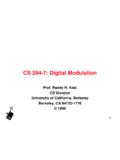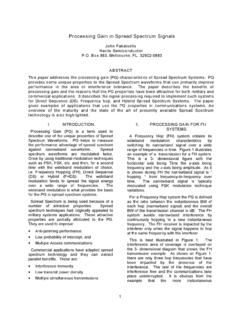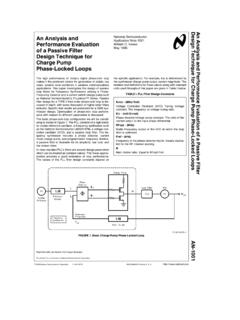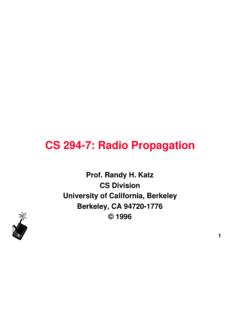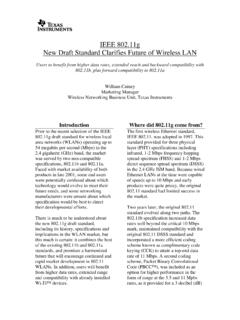Transcription of APPLICATION NOTE GMSK Practical GMSK Data Transmission
1 APPLICATION NOTEGMSK* Mobitex is a trademark owned by the Telia article reprinted with permission from Wireless Design and Development, January 1995, Volume 3 Number 1 1998 MX COM, Tel: 800 638 5577 336 744 5050 Fax: 336 744 5054 Doc. # Bethania Station Road, Winston-Salem, NC 27105-1201 trademarks and service marks are held by their respective gmsk DataTransmissionPractical gmsk Data TransmissionIntroductionThe proliferation of computers in today's society has increased the demand for Transmission of data overwireless links. Binary data, composed of sharp "one to zero" and "zero to one" transitions, results in aspectrum rich in harmonic content that is not well suited to RF Transmission .
2 Hence, the field of digitalmodulation has been flourishing. Recent standards such as Cellular Digital Packet Data (CDPD) and Mobitex*specify Gaussian filtered Minimum Shift Keying ( gmsk ) for their modulation is a simple yet effective approach to digital modulation for wireless data Transmission . To provide agood understanding of gmsk , we will review the basics of MSK and gmsk , as well as how gmsk isimplemented in CDPD and Mobitex modems reduce system complexity, and in turn lower system cost. There are, however, someimportant implementation details to be considered. This paper will cover some of these details, focusing oninterfacing a single chip baseband modem to the IF/RF section of a "typical" FM radio we look at a Fourier series expansion of a data signal we see harmonics extending to infinity.
3 When theseharmonics are summed, they give the data signal its sharp transitions. Hence, an unfiltered NRZ data streamused to modulate an RF carrier will produce an RF spectrum of considerable bandwidth. Of course, the FCChas strict regulations about spectrum usage and such a system is generally considered impractical. But if westart to remove the high frequency harmonics from the Fourier series ( pass the data signal through alowpass filter), the transitions in the data will become progressively less sharp. This suggests that pre-modulation filtering is an effective method for reducing the occupied spectrum for wireless data addition to a compact spectrum, a wireless data modulation scheme must have good bit error rate (BER)performance under noisy conditions.
4 Its performance should also be independent of power amplifier linearityto allow the use of class C power academic field of Data Transmission is loaded with modulation strategies that attempt to meet theabove criteria. Most involve translation of data bits or patterns into a particular combination of phase,frequency or amplitude. Some of the more notable techniques are listed in Table TECHNIQUECOMMON ACRONYMF requency Shift KeyingFSKM ulti-level Frequency Shift KeyingMFSKC ontinuous Phase Frequency Shift KeyingCPFSKM inimum Shift KeyingMSKG aussian Minimum Shift KeyingGMSKT amed Frequency ModulationTFMP hase Shift KeyingPSKQ uadrature Phase Shift KeyingQPSKD ifferential Quadrature Phase Shift KeyingDQPSKPi/4 Differential Quadrature Phase Shift KeyingPi/4 DQPSKQ uadrature Amplitude ModulationQAMT able 1: Modulation FormatsGMSK Practical gmsk Data Transmission2 APPLICATION Note 1998 MX COM, Tel: 800 638 5577 336 744 5050 Fax: 336 744 5054 Doc.
5 # Bethania Station Road, Winston-Salem, NC 27105-1201 trademarks and service marks are held by their respective of the modulation formats listed in Table 1 is suited to specific applications . In general, schemes thatrely on more than two levels ( QAM, QPSK) require better signal to noise ratios (SNR) than two-levelschemes for similar BER performance. Additionally, in a wireless environment, multi-level schemes generallyrequire greater power amplifier linearity than two-level schemes. The fact that gmsk uses a two-levelcontinuous phase modulation (CPM) format has contributed to its popularity. Another point in its favor is that itallows the use of class C power amplifiers (relatively non-linear) and data rates approaching the channel BW(dependent on filter bandwidth and channel spacing).
6 gmsk BasicsPrior to discussing gmsk in detail we need to review MSK, from which gmsk is derived. MSK is acontinuous phase modulation scheme where the modulated carrier contains no phase discontinuities andfrequency changes occur at the carrier zero crossings. MSK is unique due to the relationship between thefrequency of a logical zero and one: the difference between the frequency of a logical zero and a logical oneis always equal to half the data rate. In other words, the modulation index is for MSK, and is defined asm = f x Twhere, f = |flogic 1 flogic 0|T = 1/bit rateFor example, a 1200 bit per second baseband MSK data signal could be composed of 1200 Hz and 1800 Hzfrequencies for a logical one and zero respectively (see Figure 1).
7 T(a)t(b)101200 Hz1800 Hz1200 Hz1200 Hz11 Figure 1: 1200 baud MSK data signal; a) NRZ data, b) MSK MSK, as shown in Figure 1, is a robust means of transmitting data in wireless systems where thedata rate is relatvely low compared to the channel BW. MX-COM devices such as the MX429 and MX469 aresingle chip solutions for baseband MSK systems, incorporating modulation and demodulation circuitry on asingle alternative method for generating MSK modulation can be realized by directly injecting NRZ data into afrequency modulator with its modulation index set for (see Figure 2). This approach is essentiallyequivalent to baseband MSK. However, in the direct approach the VCO is part of the RF/IF section, whereasin baseband MSK the voltage to frequency conversion takes place at Practical gmsk Data Transmission3 APPLICATION Note 1998 MX COM, Tel: 800 638 5577 336 744 5050 Fax: 336 744 5054 Doc.
8 # Bethania Station Road, Winston-Salem, NC 27105-1201 trademarks and service marks are held by their respective = 2: Direct MSK modulationThe fundamental problem with MSK is that the spectrum is not compact enough to realize data ratesapproaching the RF channel BW. A plot of the spectrum for MSK reveals sidelobes extending well above thedata rate (see Figure 4). For wireless data Transmission systems which require more efficient use of the RFchannel BW, it is necessary to reduce the energy of the MSK upper sidelobes. Earlier we stated that astraightforward means of reducing this energy is lowpass filtering the data stream prior to presenting it to themodulator (pre-modulation filtering).
9 The pre-modulation lowpass filter must have a narrow BW with a sharpcutoff frequency and very little overshoot in its impulse response. This is where the Gaussian filtercharacteristic comes in. It has an impulse response characterized by a classical Gaussian distribution (bellshaped curve), as shown in Figure 3. Notice the absence of overshoot or 3: Gausssian filter impluse response for BT = and BT = 3 depicts the impulse response of a Gaussian filter for BT = and BT is related to the filter s -3dB BW and data rate byRATE BITfBTdB3 Hence, for a data rate of kbps and a BT of , the filter s -3dB cutoff frequency is Practical gmsk Data Transmission4 APPLICATION Note 1998 MX COM, Tel: 800 638 5577 336 744 5050 Fax: 336 744 5054 Doc.
10 # Bethania Station Road, Winston-Salem, NC 27105-1201 trademarks and service marks are held by their respective referring to Figure 3, notice that a bit is spread over approximately 3 bit periods for BT= and two bitperiods for BT= This gives rise to a phenomena called inter-symbol interference (ISI). For BT= symbols or bits will interfere with each other more than for BT= gmsk with BT= is equivalent toMSK. In other words, MSK does not intentionally introduce ISI. Greater ISI allows the spectrum to be morecompact, making demodulation more difficult. Hence, spectral compactness is the primary trade-off in goingfrom MSK to Gaussian pre-modulation filtered MSK. Figure 4 displays the normalized spectral densities forMSK and gmsk .
